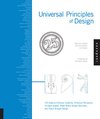Universal Principles of Design, Revised and Updated: 125 Ways to Enhance Usability, Influence Perception, Increase Appeal, Make Better Design Decisions, and Teach through Design
William Lidwell, Kritina Holden, Jill Butler
amazon.com
Universal Principles of Design, Revised and Updated: 125 Ways to Enhance Usability, Influence Perception, Increase Appeal, Make Better Design Decisions, and Teach through Design
William Lidwell, Kritina Holden, Jill Butler
amazon.com
Consider desire lines in projects that emphasize usability. When possible, use creative methods to detect desire lines prior to finalizing design specifications.
high percentage of effects in any large system are caused by a low percentage of variables.1
Homogenous redundancy is the use of multiple elements of a single type (e.g., use of multiple independent strands to compose a rope).
The strongest effect is achieved when exposures are so brief or subtle that they are subliminal (not consciously processed), or when they are separated by a delay.3
prevent garbage in. Use affordances and constraints to minimize problems of type. Use previews and confirmations to minimize problems of quality. When input integrity is critical, use validation tests to check integrity prior to input, and consider confirmation steps that require the independent verification of multiple people.
In decision-making situations, if the decision is to be made immediately after the presentation of the last item, increase the probability of an item being selected by presenting it at the end of the list; otherwise, present it at the beginning of the list.
A tendency to assume that a system that works at one scale will also work at a smaller or larger scale.1
weakest link in a system can function in one of two ways: it can fail and passively minimize damage, or it can fail and activate additional systems that actively minimize damage. An example of a passive design is the use of fuses in electrical circuits as described above. An example of an active design is the use of automatic sprinklers in a
... See moreFinancial status is biologically important because it ensures a woman of security and status for herself and her children. However,